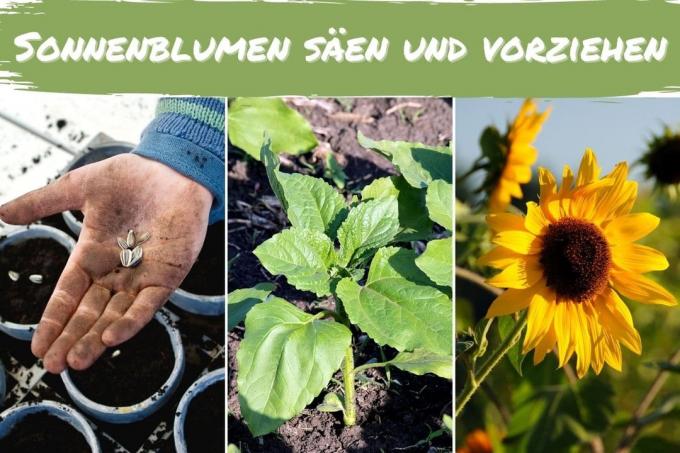
table of contents
- Instructions for direct sowing
- Location and soil
- Sow sunflowers
- Instructions for preferring
- Sow sunflowers
- Location and care
- Select seedlings
- Sunflowers for tub culture
- Sow sunflowers
- frequently asked Questions
Sunflowers, bot. Helianthus, are annual and have to be replanted every year. Alternatives to buying young plants for garden beds and pots are direct sowing and growing your own plants.
In a nutshell
titleInstructions for direct sowing
Sowing Helianthus begins in autumn with the harvest of the kernels containing the seeds. It is up to you whether you remove the sunflower seeds from the dried flowers or leave them in there until next spring. It is important that you store the kernels in a warm and dry place over the winter.

time
The ideal time to sow sunflowers has come when the soil has reached a temperature of seven to eight degrees Celsius. According to the calendar, this is the case in this country in mild regions in April. The surefire way, however, is to wait until mid-May (after the ice saints) before sowing.
Tip: Since it takes about eleven weeks from seed to flowering, you can get the Sunflower bloom by inserting the cores into the earth at different times.
With time-shifted sowing, it is ideal if you sow one week apart. New sunflower blossoms are constantly developing in summer. In this case, the last sowing takes place at the end of June / beginning of July so that the last sunflowers make it to bloom.
Location and soil
As their name suggests, sunflowers need a sunny spot. In addition, it should be protected from the wind so that the plants do not kink. The floor ideally has the following properties:
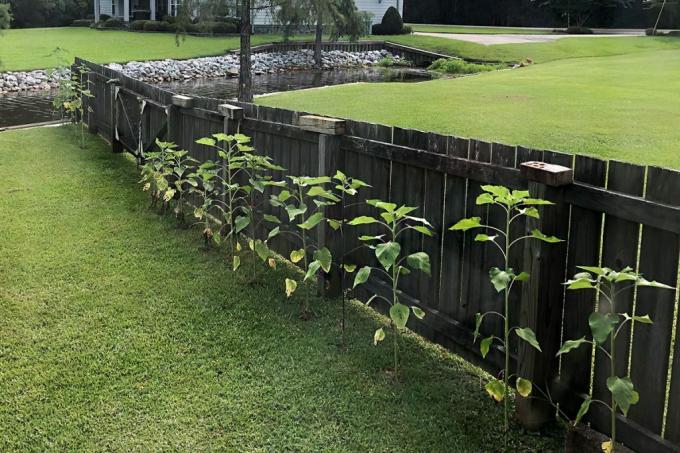
- nutritious
- permeable
- loamy to sandy
Sow sunflowers
When sowing sunflowers, you should keep the plants spaced as there are differences between the different species. For example, the planting distance is from
- Perennial sunflower, Helianthus decapetalus and Helianthus microcephalus 70 to 100 centimeters
- Wire-haired perennial sunflower, Helianthus atrorubens 50 to 75 centimeters
- Hairy sunflower, Helianthus mollis 70 centimeters
- Giant perennial sunflower, Helianthus giganteus 50 centimeters
If you have decided on the staggered appearance, you should put the sunflower seeds into the ground at greater intervals so that the plants that are sown later have sufficient space.
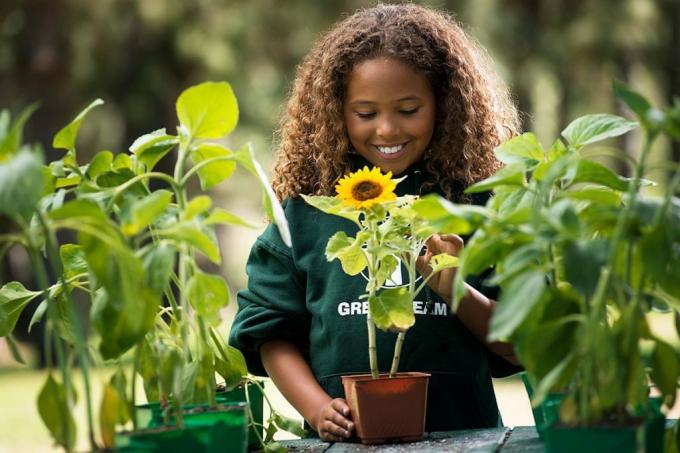
There are no differences between the different species and varieties in terms of the seed depth of the kernels. This is why all the seeds are about four to six centimeters deep in the ground.
care
Sunflowers not only love the sun, they also need a lot of water right from the start. That is why the soil must never dry out after sowing. It is only fertilized when the seeds have developed into stately young plants.
Instructions for preferring
Bringing Helianthus forward is not absolutely necessary, but it does have the advantage that they start to flower earlier. Because the summer bloomers are preferred indoors from mid / late March when it is still too cold for sowing in the garden.
If the sunflowers are to be planted outdoors later, you will need in addition to the seeds:
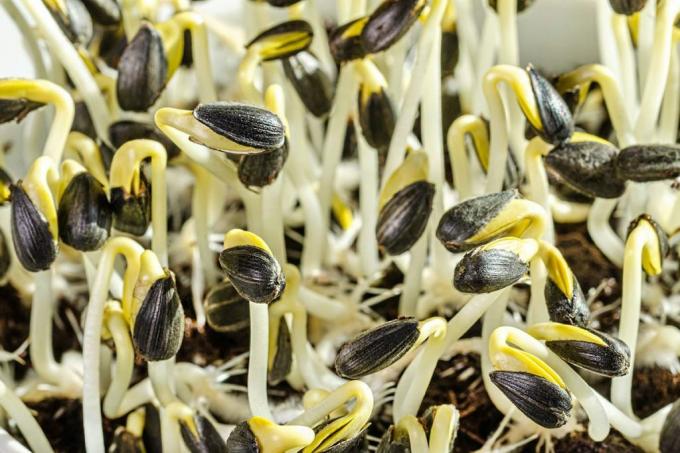
- Seed pots, small flower pots (ten to twelve centimeters in diameter)
- normal garden soil
Sow sunflowers
In the first step, fill the pots with the garden soil. After that, you can put the seeds in the soil:
- between three and five sunflower per planter
- Depth: about two centimeters
- cover with earth
- Moisten the substrate slightly
Tip: In any case, you should sow more seeds than you will need later on plants, because a seedling does not develop from every core.
Location and care
Place the pots next to one for germination
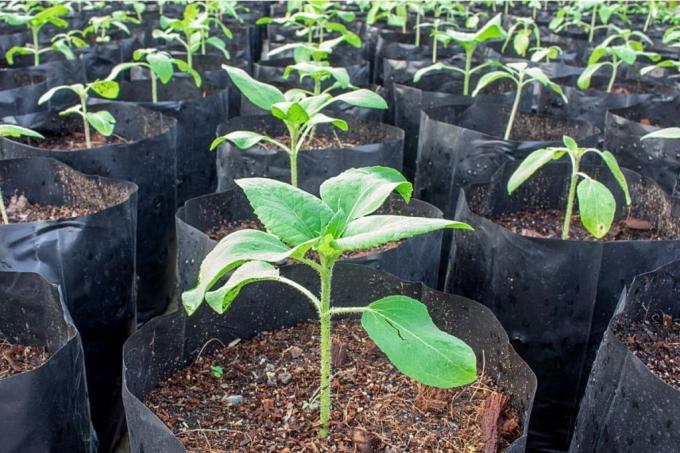
- bright location without direct sunlight (e.g. B. a windowsill)
- with a temperature of 15 degrees Celsius
Select seedlings
After the germination period of one to two weeks, it is important to take a critical look at the seedlings, because only the strongest are cultivated in the garden until they are planted out. Therefore, remove the weaker specimens so that only one sunflower remains per pot.
These plants now come to a sunny location at a temperature of 15 degrees Celsius. Until they are planted out after the ice saints, they need regular watering so that the little plants can develop into strong young plants.
Sunflowers for tub culture
Helianthus not only grows in the garden, but can also be kept in a bucket. In theory, you can move plants that have already been grown into a larger planter for the balcony or terrace. In practice, however, it is advisable to sow the kernels directly into the intended pot (bucket, etc.).

preparation
For no-till you need a bucket with a diameter of at least 35 centimeters. For larger varieties, a flower pot with a minimum volume of 18 liters is recommended. You should sow larger species in a heavy clay pot so that the sunflower does not fall over so quickly in the wind. The plants do not have any special demands on the substrate. However, since they are among the strong eaters, a soil rich in nutrients and minerals is recommended for the bucket culture.
Tip: So that the sunflower does not suffer from waterlogging later, the pot should have drainage holes. You should also create a drainage layer made of potsherds and gravel on the bottom of the pot.
Sow sunflowers
Since the space in the tub is limited, you should only grow one sunflower per planter. Nevertheless, you put three sunflower seeds in each pot at a depth of four to six centimeters. This increases your chances of success, because not every seed produces a plant. Water the seeds well and make sure that the substrate does not dry out. If you are spoiled for choice after germination, only the strongest sunflower will remain in the pot.
frequently asked Questions
The subsequent relocation of the plants is possible if, for example, it turns out that the planting distance is too small.
Yes, snails are a threat to plants. It is therefore advisable to protect the offspring from the voracious animals with a barrier.
Nothing contradicts this, but it remains a surprise which sunflower grows from the bird seed.
